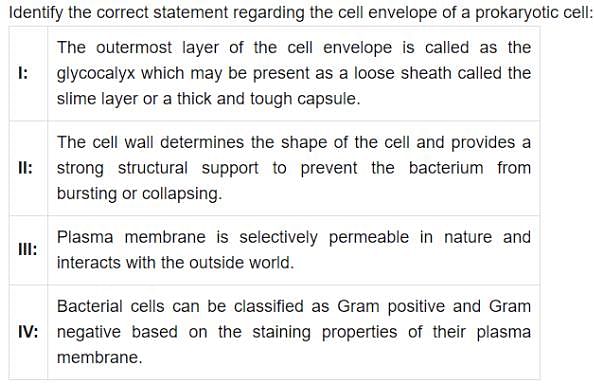NEET Exam > NEET Tests > Topic-wise MCQ Tests for NEET > Test: Cytoplasm - 2 - NEET MCQ
Test: Cytoplasm - 2 - NEET MCQ
Test Description
29 Questions MCQ Test Topic-wise MCQ Tests for NEET - Test: Cytoplasm - 2
Test: Cytoplasm - 2 for NEET 2025 is part of Topic-wise MCQ Tests for NEET preparation. The Test: Cytoplasm - 2 questions and answers have been
prepared according to the NEET exam syllabus.The Test: Cytoplasm - 2 MCQs are made for NEET 2025 Exam. Find important
definitions, questions, notes, meanings, examples, exercises, MCQs and online tests for Test: Cytoplasm - 2 below.
Solutions of Test: Cytoplasm - 2 questions in English are available as part of our Topic-wise MCQ Tests for NEET for NEET & Test: Cytoplasm - 2 solutions in
Hindi for Topic-wise MCQ Tests for NEET course. Download more important topics, notes, lectures and mock
test series for NEET Exam by signing up for free. Attempt Test: Cytoplasm - 2 | 29 questions in 30 minutes | Mock test for NEET preparation | Free important questions MCQ to study Topic-wise MCQ Tests for NEET for NEET Exam | Download free PDF with solutions
Detailed Solution for Test: Cytoplasm - 2 - Question 1
Test: Cytoplasm - 2 - Question 2
Which among the following is incorrect about endoplasmic reticulum?
Detailed Solution for Test: Cytoplasm - 2 - Question 2
Detailed Solution for Test: Cytoplasm - 2 - Question 3
Detailed Solution for Test: Cytoplasm - 2 - Question 4
Detailed Solution for Test: Cytoplasm - 2 - Question 5
Test: Cytoplasm - 2 - Question 6
Which among the following is not correct about Golgi apparatus?
Detailed Solution for Test: Cytoplasm - 2 - Question 6
Detailed Solution for Test: Cytoplasm - 2 - Question 7
Test: Cytoplasm - 2 - Question 8
Chemical modification of substance like glycosidation of protein and lipid occur in :–
Detailed Solution for Test: Cytoplasm - 2 - Question 8
Detailed Solution for Test: Cytoplasm - 2 - Question 9
Test: Cytoplasm - 2 - Question 10
Most of the cell–organelles are derived from which structure of cell :–
Detailed Solution for Test: Cytoplasm - 2 - Question 10
Detailed Solution for Test: Cytoplasm - 2 - Question 11
Detailed Solution for Test: Cytoplasm - 2 - Question 12
Detailed Solution for Test: Cytoplasm - 2 - Question 13
Detailed Solution for Test: Cytoplasm - 2 - Question 14
Detailed Solution for Test: Cytoplasm - 2 - Question 15
Detailed Solution for Test: Cytoplasm - 2 - Question 16
Test: Cytoplasm - 2 - Question 17
During spermatogenesis golgi is thought to be responsible for the formation of :–
Detailed Solution for Test: Cytoplasm - 2 - Question 17
Detailed Solution for Test: Cytoplasm - 2 - Question 18
Detailed Solution for Test: Cytoplasm - 2 - Question 19
Test: Cytoplasm - 2 - Question 20
The cell organelles having abundance of oxidizing enzymes is :–
Detailed Solution for Test: Cytoplasm - 2 - Question 20
Detailed Solution for Test: Cytoplasm - 2 - Question 21
Detailed Solution for Test: Cytoplasm - 2 - Question 22
Detailed Solution for Test: Cytoplasm - 2 - Question 23
Test: Cytoplasm - 2 - Question 24
Which of the following is a main source of cellular membranes :–
Detailed Solution for Test: Cytoplasm - 2 - Question 24
Detailed Solution for Test: Cytoplasm - 2 - Question 25
Detailed Solution for Test: Cytoplasm - 2 - Question 26
Detailed Solution for Test: Cytoplasm - 2 - Question 27
Detailed Solution for Test: Cytoplasm - 2 - Question 28
Detailed Solution for Test: Cytoplasm - 2 - Question 29
|
9 docs|1259 tests
|
Information about Test: Cytoplasm - 2 Page
In this test you can find the Exam questions for Test: Cytoplasm - 2 solved & explained in the simplest way possible.
Besides giving Questions and answers for Test: Cytoplasm - 2, EduRev gives you an ample number of Online tests for practice





















